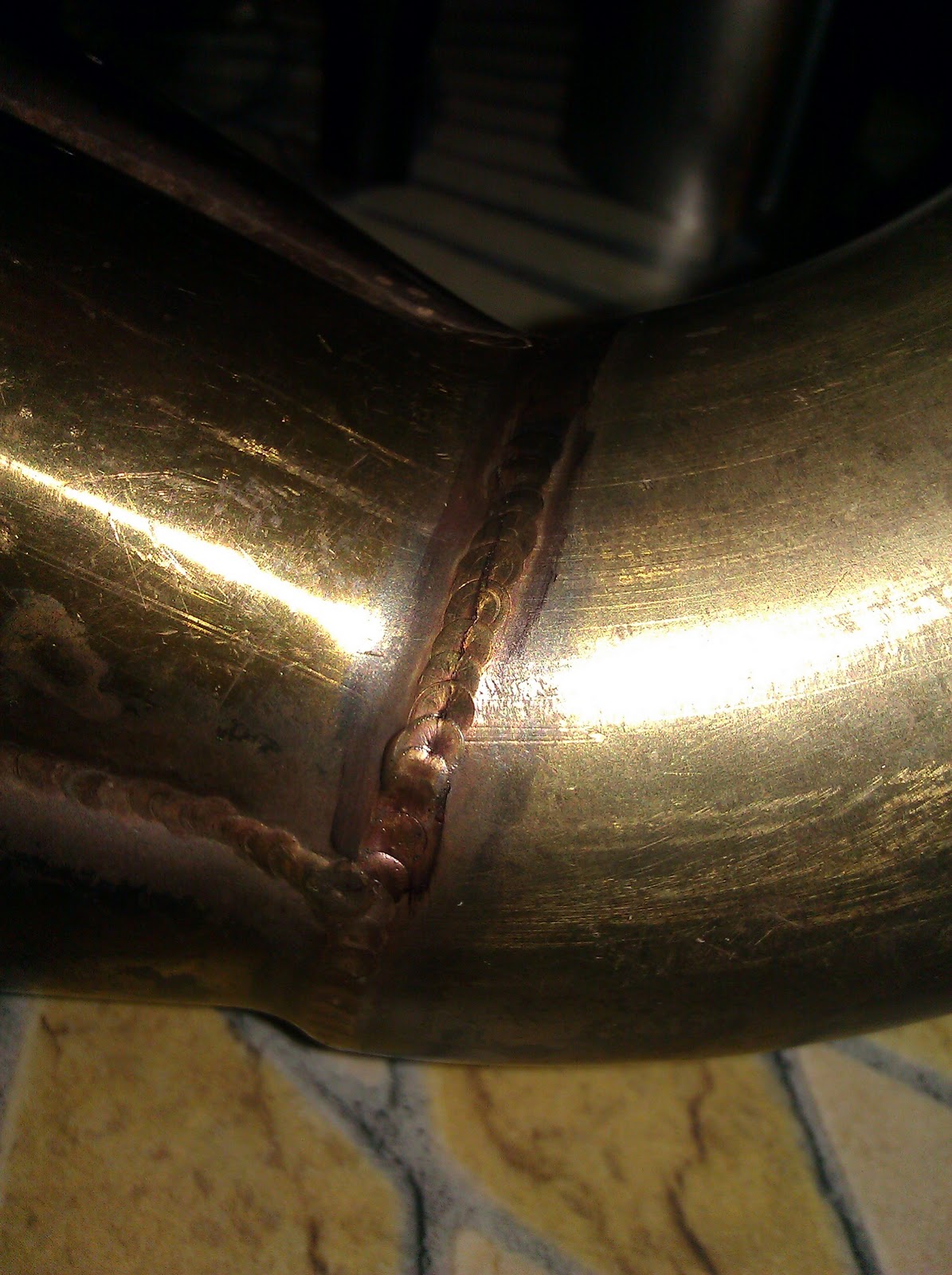I took three cones (two low angle, long divergent cones and one high angle short convergent cone), one busted Bisi header and mashed them together by cutting the header back to the goilette point, cleaning up the inside of the collector, then pie cutting one of the cones to wrap it around the pan, and then welded the other two cones into a megaphone then sized the joint to match the larger of the two primary sizes. There are a crapton of pics on my fab blog, if you prefer to see them vs. my poor short explanation.
http://beaverbuilt.blogspot.comSome other pics I don't think I posted before:


The other part of the downpipe just completely fell off, and this ^^^ "aesthetically pleasing" weld was next to break even if re-welded.
Justin actually wanted me to just re-re-re-weld the header, but after getting it in my hands, I refused to. I didn't want to cut the effer apart and and weld over already smoked metal. We discussed some other options but then he decided to let me modify the downpipe to try to extract some actual decent performance out of the header, which never was very impressive to him in the first place. I've been wanting to experiment with a small choke header for some time, and he agreed to be the guinea pig. However, neither of us actually expected the dramatically different tone (which sounds effing awesome, IMO) and performance gains. He has more torque everywhere and it doesn't fall off much at all, where before it would nosedive after 7K.
As mentioned before, his is a stock cammed (Y8) high compression (13.5:1 or thereabouts) engine that being run at 6000ft about sea level in Colorado. His goals are to be the first NA D to run 13s at the track he races at, which is tough considering most B-equipped vehicles have a hard time doing it. He missed his goal to have the car at the track on opening day due to a few things out of his control, but his new goal is to get it to the track within the next two weeks and get a time slip.
He still has a bunch of tuning to do. He runs on C16, I think. He just filled up and added some fuel and timing, but hasn't had enough time to get some actual datalogging done, but that is his next step. Overall, though, even with the tune being off, he says that the car has never felt as powerful, and he's had it for a long while, at least long enough to notice changes in the power curve. He's a good tuner, too, and handles a lot of Hondas in his area. (He's started posting videos of some of the cars he tunes on his youtube channel.)
He doesn't have any before dynos and only one time slip from the last time he was at the track which was in 2010, I think, with a mostly full interior and close to full weight for an '88. Lots of changes, and some might think it is all in his head, and "we" can't really "prove" anything, but as a builder of stuff, it is good to hear that a customer is so happy with your work he wants to pay for stickers to be made (out of his own pocket) to advertise my bidness.
To sum up: I am firmly convinced that the collector outlet size and primary lengths of the Bisimoto headers are spec'd to produce a bump in power at an elevated shift point commonly used in a semi-built engine used for drag racing, at the sacrifice of midrange torque (much evidence for this on DSO and HT) and also allowing the torque to drop like a rock above a certain point (depending on the rest of the engine/cam combo). By decreasing the collector outlet diameter by using the low angle merge extension (as a downpipe), velocity of the exhaust gases is not only maintained but accelerated, allowing for higher mass flow rates and most likely superior scavenging properties, much enhanced over the original design. While the primary lengths (somewhere about 26") are tuned well for a high shifting RPM peak torque, the collector hugeness is detrimental to nearly everything else except the "shift point hump." By making the changes to the collector, then adding a megaphone after the collector, I intended to and think I have actually achieved a system that actually lowers peak torqu output but spreads the peak outwards (both above and below), which yields a more linear powercurve than was previously possible with the original design.
All that is my SWAG, anyway. Seems to work well enough. I just can't wait to finish the header for the race team I consult for and get that to them. I want to see how that design performs, at least compared to your typical Moose-modded eBay header. I should have that header done next week and shipped off and hearing back from the team by the middle of June, as I know their tune will need to be adjusted (since I also tune for them).
Other things I will hopefully experiment with later this summer: The effects of various megaphone sizes:

I am thinking that will be too big, but we will see.
I think that mostly covers everything pertinent. There's a crapton more info on the construction on my blog. Lots of interesting tips, tricks and stupidity to keep even the most discerning OG entertained, as long as they want to see off the wall metal work.
 Author
Topic: Blah. Lots of y'all know who I am already. (Read 13533 times)
Author
Topic: Blah. Lots of y'all know who I am already. (Read 13533 times)


